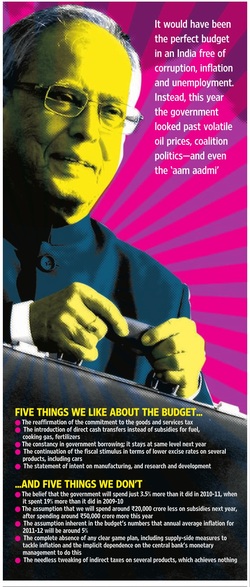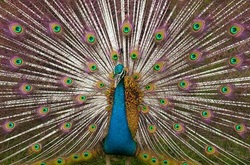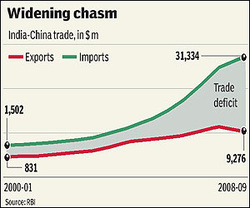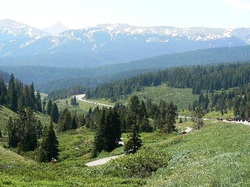Budget in brief
Economy Survey has predicted a nine per cent growth in the next fiscal and said it is poised to clock 8.6 per cent growth in this financial year. The Survey tabled in Parliament by Finance Minister Pranab Mukherjee today expresses concern over inflation and advocates for more monetary tightening by the Reserve Bank for reducing inflationary pressures.
The inflation stood at 8.23 per cent in January this year. The Survey points out that inflation could be 1.5 per cent more in future as India is on a growth path. The Survey says, despite risks of global events like volatility in commodity prices and political turmoil in the West Asia, the economy is set to grow faster and scale greater heights. It says, industrial output grew by 8.6 per cent and is concerned about the fall in factory output in the coming months. Manufacturing registered 9.1 percent growth and Exports had an impressive growth of 29.5 percent from April to December. The Survey points out that imports have also increased by 19 percent in the same period due to higher prices of crude oil and food grains. It advocates that the trade gap has narrowed to over 82 billion US dollars in the first nine months of the current fiscal and gross fiscal deficit is at 4.8 per cent which is 1.5 percent less than last fiscal. The Survey says the spending in social sector programmes has increased by five percent of the GDP over past five years. The production of food grains is estimated at over 232 million tonnes with record production of wheat. It makes a strong case for a second green revolution with technological breakthrough in agriculture sector. The Survey also brings to the fore that there is scope of further improvements in Mahatma Gandhi National Rural employment guarantee scheme for building permanent assets including infrastructure development. The Survey points out that forex reserves are estimated to be over 297 billion US dollars. This is mainly due to growth in export sector. The Survey talks about robust growth and steady fiscal consolidation as the hallmark of the Indian Economy with strong fundamentals. On the reform agenda the Survey calls for better convergence of schemes to avoid duplications and leakage and to ensure that benefits reach to the targeted groups. It also advocates for urgent need to streamline land acquisition and environment clearance for infrastructure projects and huge capacity addition in this vital sector in a time bound manner. Strongly pushing for a new goods and services tax, the Survey also suggests increasing private public partnerships in infrastructure sector. Reacting to the Economic Survey, Finance Minister Pranab Mukherjee said, inflation and widening current account deficit remain major areas of concern. He endorsed the Economic Survey's emphasis on the farm and the infrastructure sectors for achieving higher economic growth. Speaking to reporters outside Parliament, he said though there is a variation in index of industrial production in the recent months, it requires substantial investment for the industry to continue to make its contribution to GDP. Snapping two months of declining trend, foreign direct investment, FDI in India increased 30.69 per cent to about 9,000 crore rupees in December 2010. India had attracted FDI worth 7,185 crore rupees in December 2009. However, during the nine month period April to December of the current fiscal, FDI declined 23.14 per cent over the year ago period. The main sectors that attracted FDI include services (financial and non-financial), telecommunications, housing and real estate, construction activities and power. Countries including Mauritius, Singapore, US, UK, Netherlands, Japan, Germany and UAE are the major investors in India. In view of declining foreign investment inflows, the RBI is considering setting-up a panel to find out the reasons for FDI slowdown and suggest ways to encourage it. According to economists, investors are cautious as the global economic recovery is fragile and uneven, specially in Europe. India's exports grew by a healthy 32.5 per cent year-on-year to $20.6 billion in January this year on account of increasing demand in the western markets.
During April-January this fiscal, the country's shipments went up by 29.4 per cent to over 184 billion dollar. Talking to reporters in New Delhi, Commerce Secretary Rahul Khullar said, imports in January, 2011 was estimated to increase by 13.1 per cent to $28.6 billion dollar over the same period last year, leaving a trade deficit of $8 billion. He said sectors that registered healthy growth during April-January, 2010-11 included gems and jewellery, engineering and petroleum and oil lubricants. Union Finance Minister Shri Pranab Mukherjee said that the growth in GDP at market prices at 9.7 per cent for 2010-11 reflects buoyancy in our tax collections. Shri Mukherjee was reacting to the Advance Estimates of National Income for 2010-11 released by the Central Statistical Organisation (CSO) here today. Shri Mukherjee further said that coupled with higher than anticipated nominal growth in GDP will also ensure that our performance on fiscal and revenue deficit targets for the year would be better than the projections in the Budget 2010-11. Gross Domestic Product (GDP) at factor cost is estimated to increase by 8.6 per cent in 2010-11 as per CSO advance estimates. The Finance Minister said that this is in line with the Finance Ministry projections for the year as a whole. Finance Minister Shri Pranab Mukherjee said that on the supply side, strong agriculture performance aided by growth in manufacturing and services has helped in restoring high overall growth in GDP for the fiscal year 2010-11. He said that construction activity is also showing improved growth momentum. On the demand side, the Finance Minister Shri Mukherjee said while private consumption is estimated to grow at 8.2 per cent in 2010-11 over the last year, the growth in investment is anticipated at close to 9 per cent. He said that the growth in government spending is estimated to moderate significantly to 2.6 per cent in 2010-11. The export growth is projected at 12 per cent and import growth at 6.3 per cent 2010-11, the Minister added. Finance Minister Shri Pranab Mukherjee said that the strong revival in private spending and improvement in investment growth is a welcome sign. However, the Finance Minister said that we still have some distance to go before regaining the investment growth witnessed in the pre-crisis period. the Swarna Jayanti Gram Swarozgar Yojana was launched in 1999 to give financial assistance to below poverty line households in rural areas.
"Inflation is the most regressive form of taxationbecause it hits the poor the most." --Narendra Jadhav, Vice Chancellor,University of Pune.
Inflation is a rise in the prices of a specific set of goodsor services. In either case, it is measured as the percentage rate of change ofa price index. Food prices are soaring. . . all essential items likevegetables, oil, milk, sugar are getting costlier. Rentals and real estaterates have almost doubled in just a few months in most cities. The real estateprices are at record highs making life miserable, especially for people whohave migrated to cities for jobs. Inflation based on wholesale prices during the periodJanuary 1998-January 1999 was 4.6 percent, one of the lowest in the world.Today, India's inflation is rising at a fast pace and is set to cross 7%. |







 RSS Feed
RSS Feed